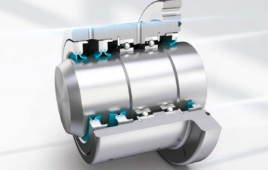Imagine being able to read real-time electronic data on a label. For instance, your barista could print out a label so you’d know exactly how hot your coffee is as time passes. Electronic labels could prove useful in a number of applications. This technology could also make printing electronic surfaces for a wide range of functions possible.
Researchers at Massachusetts Institute of Technology have developed a printing process for transistors that may make electronic labels and similar surfaces an inexpensive reality.
“There is a huge need for printing of electronic devices that are extremely inexpensive but provide simple computations and interactive functions,” says A. John Hart, the Mitsui Career Development associate professor in contemporary technology and engineering at MIT.
“Our new printing process is an enabling technology for high-performance, fully printed electronics, including transistors, optically functional surfaces, and ubiquitous sensors.”
Printing electronics is not a new concept. Inkjet and rubber stamping techniques have been used with lackluster results. According to the researchers’ paper published recently in the journal Science Advances, such techniques are difficult to control at small scales and tend to produce coffee ring patterns in which ink spills over the borders. Uneven prints can also lead to incomplete circuits.
The technique mapped out in Science Advances involves the design of nanoporous stamps – a type of stamp that’s spongier than rubber and about the size of a pinky fingernail. These stamps feature patterns smaller than the width of a human hair.
The porosity of these stamps allows a solution of nanoparticles, a sort of ink, to flow uniformly through the stamp and onto the desired surface. This allows a higher resolution than rubber stamp printing.
Carbon nanotubes are used for the stamp. These are strong, microscopic sheets of carbon atoms arranged in cylinders.
“It’s somewhat serendipitous that the solution to high-resolution printing of electronics leverages our background in making carbon nanotubes for many years,” Hart says.
“The forests of carbon nanotubes can transfer ink onto a surface like massive numbers of tiny pen quills.”
To make the stamps, the researchers used previously developed techniques to grow the carbon nanotubes on a silicon surface in various patterns, including honeycombs and flower shapes. These nanotubes were coated with a thin polymer to ensure the ink would penetrate the nanotube structures and that the nanotubes would not shrink after the ink was stamped. They then infused the stamp with a small volume of electronic ink comprised of nanoparticles like silver, zinc oxide, or semiconductor quantum dots.
The critical component to printing these precise, high-resolution patterns is in the amount of pressure applied to stamp the ink. This precise pressure was determined by a model to predict the amount of force necessary to stamp an even layer of ink onto a substrate. A printing machine made of a motorized roller was built for the process. The researchers fixed each stamp onto a platform attached to a spring, and they used this to control the force used to press the stamp against the substrate.
“This would be a continuous industrial process, where you would have a stamp, and a roller on which you’d have a substrate you want to print on, like a spool of plastic film or specialized paper for electronics,” Hart says. “We found, limited by the motor we used in the printing system, we could print at 200 millimeters per second, continuously, which is already competitive with the rates of industrial printing technologies. This, combined with a tenfold improvement in the printing resolution that we demonstrated, is encouraging.”
Filed Under: Industrial automation




